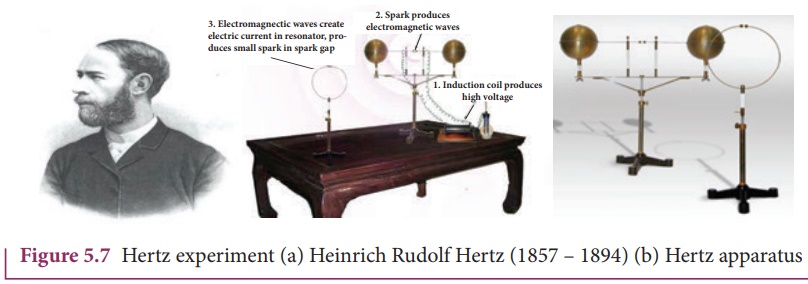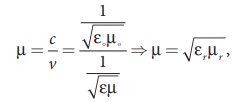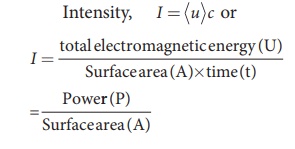Chapter: 12th Physics : Electromagnetic Waves
Production and properties of electromagnetic waves - Hertz experiment
Electromagnetic Waves
Electromagnetic waves
are non-mechanical waves which move with speed equals to the speed of light (in
vacuum). It
is a transverse wave. In the following subsections, we discuss the production
of electromagnetic waves and its properties, sources of electromagnetic waves
and also classification of electromagnetic spectrum.
Production and properties of
electromagnetic waves - Hertz experiment
MaxwellŌĆÖs prediction was
experimentally confirmed by Heinrich Rudolf Hertz (Figure 5.7 (a)) in 1888. The
experimental set up used is shown in Figure 5.7 (b).
It consists of two metal electrodes which are made of small spherical metals as shown in Figure 5.7. These are connected to larger spheres and the ends of them are connected to induction coil with very large number of turns. This is to produce very high electromotive force (emf).

Since the coil is maintained at
very high potential, air between the electrodes gets ionized and spark (spark
means discharge of electricity) is produced. The gap between electrode (ring
type ŌĆō not completely closed and has a small gap in between) kept at a distance
also gets spark. This implies that the energy is transmitted from electrode to
the receiver (ring electrode) as a wave, known as electromagnetic waves. If the
receiver is rotated by 90┬░ - then no spark is observed by the receiver. This
confirms that electromagnetic waves are transverse waves as predicted by
Maxwell. Hertz detected radio waves and also computed the speed of radio waves
which is equal to the speed of light (3 ├Ś
108 m s-1).
Properties of electromagnetic waves
1. Electromagnetic waves
are produced by any accelerated charge.
2. Electromagnetic waves
do not require any medium for propagation. So electromagnetic wave is a
non-mechanical wave.
3. Electromagnetic waves
are transverse in nature. This means that the oscillating electric field
vector, oscillating magnetic field vector and propagation vector (gives
direction of propagation) are mutually perpendicular to each other.
The electric and
magnetic fields are in the y and z directions respectively and the direction of
propagation is along x direction. This is shown in Figure 5.8.
4. Electromagnetic waves
travel with speed which isequal to the speed of light in
vacuum or free
space,
 = 3x108 ms-1,
where ╬Ąo is the permittivity of free
space or vacuum and ┬Ąo is the permeability of free space or vacuum
(refer Unit 1 for permittivity and Unit 3 for permeability).
= 3x108 ms-1,
where ╬Ąo is the permittivity of free
space or vacuum and ┬Ąo is the permeability of free space or vacuum
(refer Unit 1 for permittivity and Unit 3 for permeability).
5. In a medium with permittivity
╬Ą and permeability ┬Ą, the speed of electromagnetic wave is less than speed in
free space or vacuum, that is, < c. In a medium of refractive index,

where ╬Ąr is the
relative permittivity of the medium (also known as dielectric constant) and ┬Ąr
is the relative permeability of the medium.
6. Electromagnetic waves
are not deflected by electric field or magnetic field.

7. Electromagnetic waves
can show interference, diffraction and can also be polarized.
8. The energy density (energy
per unit volume) associated with an electromagnetic wave propagating in vacuum
or free space is

where, 1/2 ╬Ą E2 = uE
is the energy density in an electric field and 1/2┬Ą0 = B2 = uB is
the energy density in a magnetic field.
Since, E = Bc ŌćÆ uB = uE.
The energy density of
the electromagnetic wave is

9. The average energy density
for electromagnetic wave,

10. The energy crossing
per unit area per unit time and perpendicular to the direction of propagation
of electromagnetic wave is called the intensity.

11. Like other waves,
electromagnetic waves also carry energy and momentum. For the electromagnetic
wave of energy U propagating with speed c has linear momentum which
is given by = Energy / speed = U / c . The
force exerted by an electromagnetic wave on unit area of a surface is called
radiation pressure.
12. If the electromagnetic
wave incident on a material surface is completely absorbed, then the energy
delivered is U and momentum imparted on the surface is p = U/c .
13. If the incident
electromagnetic wave of energy U is totally reflected from the surface, then
the momentum delivered to the surface is Ōłåp

14. The rate of flow of
energy crossing a unit area is known as pointing vector for electromagnetic
waves, which is  .
The unit for pointing vector is W m-2. The pointing vector at any
point gives the direction of energy transport from that point.
.
The unit for pointing vector is W m-2. The pointing vector at any
point gives the direction of energy transport from that point.
15. Electromagnetic
waves carries not only energy and momentum but also angular momentum.
EXAMPLE 5.2
The relative magnetic
permeability of the medium is 2.5 and the relative electrical permittivity of
the medium is 2.25. Compute the refractive index of the medium.
Solution
Dielectric constant
(relative permeability of the medium) is ╬Ąr = 2.25
Magnetic permeability is
┬Ąr = 2.5
Refractive index of the
medium,
n = ŌłÜ ╬Ąr┬Ąr = ŌłÜ [2 . 25 ├Ś 2.5] = 2.37
Related Topics